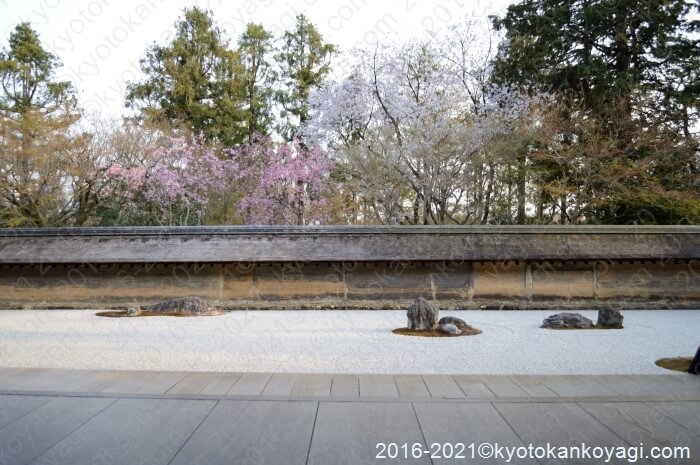THE GIST OF THIS ARTICLE
- This page Introduction, what is religious syncretism, Shinto found in The Rock Garden
- Page 2 Four kinds of Niwa, Buddhism found in The Rock Garden, Conclusion
The following is the contents of this page.
Introduction
The Zen garden/Rock Garden of Ryoanji temple is one of the most famous gardens in Japan.
In this post, we learn about the religious syncretism it hides behind in historical point of view.

It’s gonna be a long story, O.K.?
What is religious syncretism?
Religious syncretism means a fusion of diverse religious belief.
Japan has Shinto, the indigenous religion to it for centuries. No one can tell when it was originated but some ruins tell us that it has over 2,000 years of history.
In the 6th century, Buddhism was brought to our country from India. Since then, both of them have been fused and coexisted in a phenomenon called Shinbutsu Shugo(神仏習合).
We can find an example of this coexistence in “The rock garden” of Ryoanji.
Shinto found in The Rock Garden
Niwa and Kami
“The Rock garden” is a kind of Teien (Garden in English). The word is derived from “Niwa.”
In the authentic sense, Niwa means a place where some activity is carried on. The most important thing took place there were ritual and prayer.
In prehistoric times, our ancestors considered mountains as one of the places to which Kami descend. Kami, known as Shinto Deity today, is spirit(s) we found in natural phenomena or nature itself. For example, mountains provided our ancestors with wild food resources and were very closed to them and they showed respect and gratitude for nature.
They left the mountains
In Yayoi period (300 BC to 300 AD), rice cultivating was brought to Japan from ancient China, our ancestors left mountains and started to live in plains for rice paddy but they still considered mountains as one of the most sacred places.
『古事記(Kojiki)』, the earliest chronicle on Japanese history, describes Kami and the history of the Japanese Imperial family, puts it: 於御諸山 拜祭意富美和之大神前.
The sentence shows us the way a priest carries out a ritual in the mountain (山).
In the 6th century, Shinto shrines were developed as permanent place to hold ritual under the influence of Buddhism. They were build with Chinshu no Mori forest (糺の森) as a substitute for the mountains because they still wanted the sacred place for rituals and prayers though they left the places they used to live in.
Niwa for rituals
『古事記(Kojiki)』also puts it: 爾出雲國造之祖・名岐比佐都美、餝青葉山而立其河下、將獻大御食之時、其御子詔言「是於河下、如青葉山者、見山非山。若坐出雲之石之曾宮、葦原色許男大神以伊都玖之祝大廷乎。」
It narrates a ritual held in a garden where a tree ornamented with lots of leaves and the tree is a substitute for mountain. It shows us that the garden was a place for ritual but a mountain was still in need as a place for ritual.
『日本書記(Nihon Shoki)』, the second oldest chronicle on Japanese history puts it: 天照大神、手持寶鏡、授天忍穗耳尊而祝之曰「吾兒、視此寶鏡、當猶視吾。可與同床共殿、以爲齋鏡。」復勅天兒屋命・太玉命「惟爾二神、亦同侍殿內、善爲防護。」又勅曰「以吾高天原所御之穗、亦當御於吾兒。」
This is one of the most famous episodes in Japanese mythology. It describes Amaterasu Ohomikami (天照大神), the ancestor of the Imperial family, gave Ameno Oshihomimi (授天忍穗耳尊) a rice plant and an order to feed Japan with it. Now Ameno Oshihomimi is permitted to reign the country. The rice plant he were given used to belong to Yuniwa(齋庭), the sacred garden.
『万葉集(Manyoshu)』, the oldest compilation of Waka poem and known as the source of the name of the Imperial period Reiwa, puts it: 尓波(Niwa)奈加能 阿須波乃可美尓 古志波佐之 阿例波伊波々牟 加倍理久麻泥尓.
The poem is roughly translated in modern Japanese as 庭中の阿須波の神に小柴さし我れは斎はむ帰り来までに. It means that I hold a small ritual and pray that I shall come back here again in Niwa.
The Wakas in Manyoshu were composed by people in various classes. It tells us that Niwa was a popular place for rituals those days.
The most appropriate example for the usage of Niwa is Gion Matsuri festival. It was started as a Buddhist ritual called Gion Goryoe held in a private garden of the emperor called Shinsen-en. It may sound strange to you but it is very appropriate in terms of the role of Niwa.
ヤギの京都観光案内/KYOTO GOAT BLOGをもっと見る
購読すると最新の投稿がメールで送信されます。



